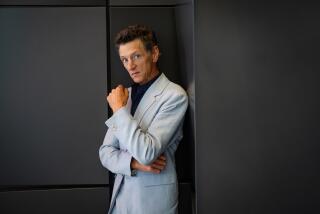Review: ‘Theory of Everything’ makes the cosmos of a marriage shine
- Share via
The field that made scientist Stephen Hawking an international celebrity may be physics, but the reason “The Theory of Everything” is emotionally effective as an examination of his life and thought comes down to chemistry, the interconnected performances of Eddie Redmayne and Felicity Jones.
Redmayne and Jones are beautifully compatible as Hawking and his then-wife Jane as they navigate the ebb and flow of 25 years of their relationship, a subtle, nuanced connection that posits that the complexities of the universe are nothing compared with the intricacies of the human heart.
Hawking’s public story, surviving for half a century with a disease that was supposed to kill him within two years and going on to write the 10-million-copy-selling “A Brief History of Time,” is a tale it would be impossible to make up.
Oscars 2015: Full coverage
But “Theory of Everything” screenwriter Anthony McCarten has smartly gone further. Working from Jane Hawking’s memoir, “Travelling to Infinity: My Life With Stephen,” he’s expertly emphasized the personal side of the story, which involves not only a marriage coping with the ravages of disease but also coming to terms with the kinds of interpersonal challenges neither of the partners expected when they married.
Though he’s not usually thought of as a dramatic filmmaker and risks becoming overshadowed by the justifiable praise that Redmayne’s uncanny performance has been getting, director James Marsh’s contribution here is considerable.
Best known in this country for his documentary films, including the Oscar-winning “Man on Wire” and “Project Nim,” Marsh has done strong narrative work, including one part of the too-little-seen “Red Riding” trilogy and the neglected “Shadow Dancer.”
A director with a natural gift for telling stories, Marsh makes the most of McCarten’s effective script. There’s a real energy to his filmmaking, the ability to be intelligently dramatic without overdoing things that is ideally suited to material that would be so easy to get wrong.
Perhaps because most people’s image of Hawking is of the gnome-like man with a computerized voice (it’s his trademarked one we hear in the film) and an electronic wheelchair, “Theory” begins with the scientist as an exuberant English graduate student riding his bicycle hellbent for leather down the narrow streets of Cambridge’s university town in 1963.
Hawking’s brilliance as a cosmologist searching for “one single unifying theory” to solve the riddle of the universe is already apparent to his teachers, but it cuts no ice with the women who attend a mixer with him and his friends. “Oh, dear — scientists,” one of the young women says. “We don’t have to stay for long.”
But when Jane Wilde and Hawking get a glimpse of each other, something magical happens, and one of the pleasures of “Theory” is how exactly it captures this awkward, timid but unmistakable mutual attraction as it begins and flowers. The simple act of being likable on screen is no small matter, and Redmayne and Jones absolutely get it right.
Then a shadow falls on this Edenic situation as Hawking starts to experience difficulty with motion control. He is diagnosed with motor neuron disease, a progressive nerve disorder that affects speaking, walking, breathing and swallowing. “Your thoughts will not be affected,” a doctor tells him, “but no one will know what they are.”
Beyond distraught, Hawking doesn’t even want to tell Jane the news, but when she finds out, she displays an unexpected fierceness. She insists that their life together will go on, that they will be together for as long as they can. Hawking agrees, and a wedding takes place with the groom leaning on a cane for support.
Redmayne, best known for his role on stage in “Red” and in film in “Les Miserables,” gives a performance that is remarkable by any standard. The actor put in months of preparation, working with movement and vocal coaches and visiting real MND patients, and his ability to re-create numerous, at times painful to watch, stages of the disease is especially amazing when you realize the film was not shot in sequence.
Helping considerably is having a performer as strong and subtle as Jones, memorable in “The Invisible Woman” and “Like Crazy,” to work off of in a scenario that charts a fraught and complicated relationship.
While Hawking’s scientific work, especially his theories about the nature of black holes and the origins of the universe, is given its due, the focus here is always on the personal, on the daunting complications this very unusual couple faced.
Anyone who has read about the real story of the Hawkings’ marriage will be waiting for the appearance of two people who figure significantly in it, choirmaster Jonathan Hellyer (Charlie Cox) and nurse/speech therapist Elaine Mason (Maxine Peake).
It’s typical of the largeness of spirit with which “Theory of Everything” has been made that no matter how challenging the relationships get, no one here is depicted in a negative light. This is a dramatization that Hawking himself has called “broadly true,” a story whose honesty we want to believe in. It is fortunate that it has the kind of exceptional cast that allows us to do just that.
Twitter: @KennethTuran
---------------------------------
‘The Theory of Everything’
MPAA rating: PG-13 for some thematic elements and suggestive material.
Running time: 2 hours, 3 minutes
Playing: In limited release
More to Read
Only good movies
Get the Indie Focus newsletter, Mark Olsen's weekly guide to the world of cinema.
You may occasionally receive promotional content from the Los Angeles Times.











